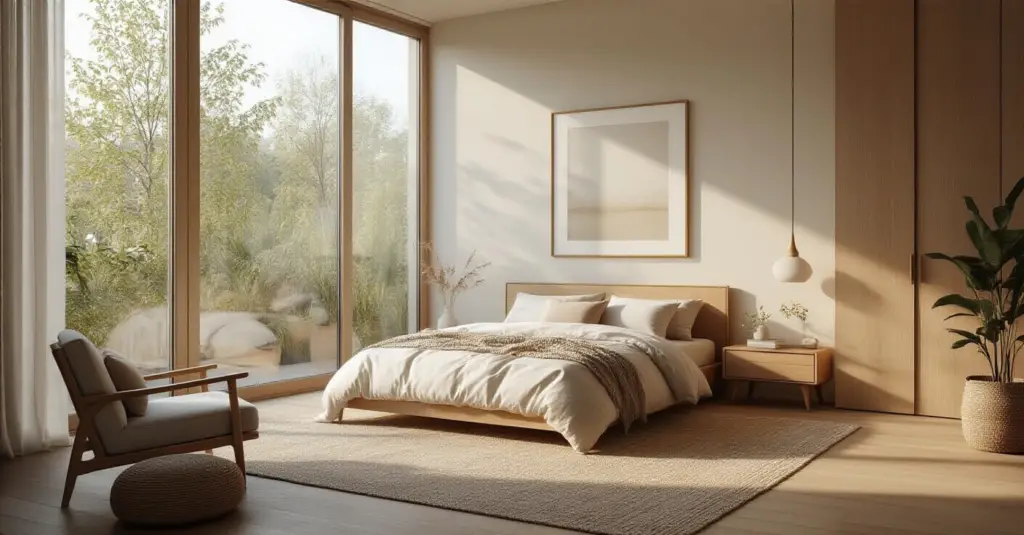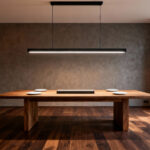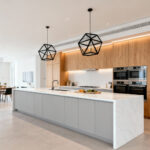Can we just talk for a second about why everyone gets “modern bedrooms” wrong? People hear “modern” and they picture this cold, sterile, all-white box where you’re afraid to actually, you know, live. It looks like an art gallery you can’t touch, or a hospital room that someone slapped a high-end price tag on. That’s just noise. Corporate speak. Total BS.
A great modern bedroom isn’t a museum. It’s your personal command center. It’s the recharge station for your life. This is where you gear up for the day and unwind from it. And if you’re someone like me who loves hosting, having people over, and creating amazing memories, this room is the secret weapon. It’s where you reset so you can be the host with the most, the friend with the energy, the person who’s ready to connect. It should be smart, outrageously comfortable, and a true reflection of you—not some sterile photo from a catalog.
So, let’s ditch the boring stuff and talk about what actually matters. Here are 20 ideas to create a modern bedroom you’ll absolutely love spending time in.
Mastering Modern Aesthetic Foundations
Okay, before you even think about buying a cool lamp or a fancy bed, we need to lay the groundwork. This is the operating system for your room. Get this right, and everything else is just an easy software update. Get it wrong, and you’re fighting glitches and lag from day one.
1. Define Your Personal Modern Style Aesthetic Effectively.
People always ask me, “Where do I even start?” And I tell them to forget the trends for a minute and define the mission. What is this room’s job? Are you building a “Calm Command Center” for intense focus and rest? A “Minimalist Media Hub” for late-night movies and gaming? Or a “Warm Recharge Zone” that’s all about soft textures and unplugging? Nailing this down isn’t some fluffy design-school exercise; it’s the filter that stops you from wasting a ton of money on stuff that looks cool separately but creates chaos together.
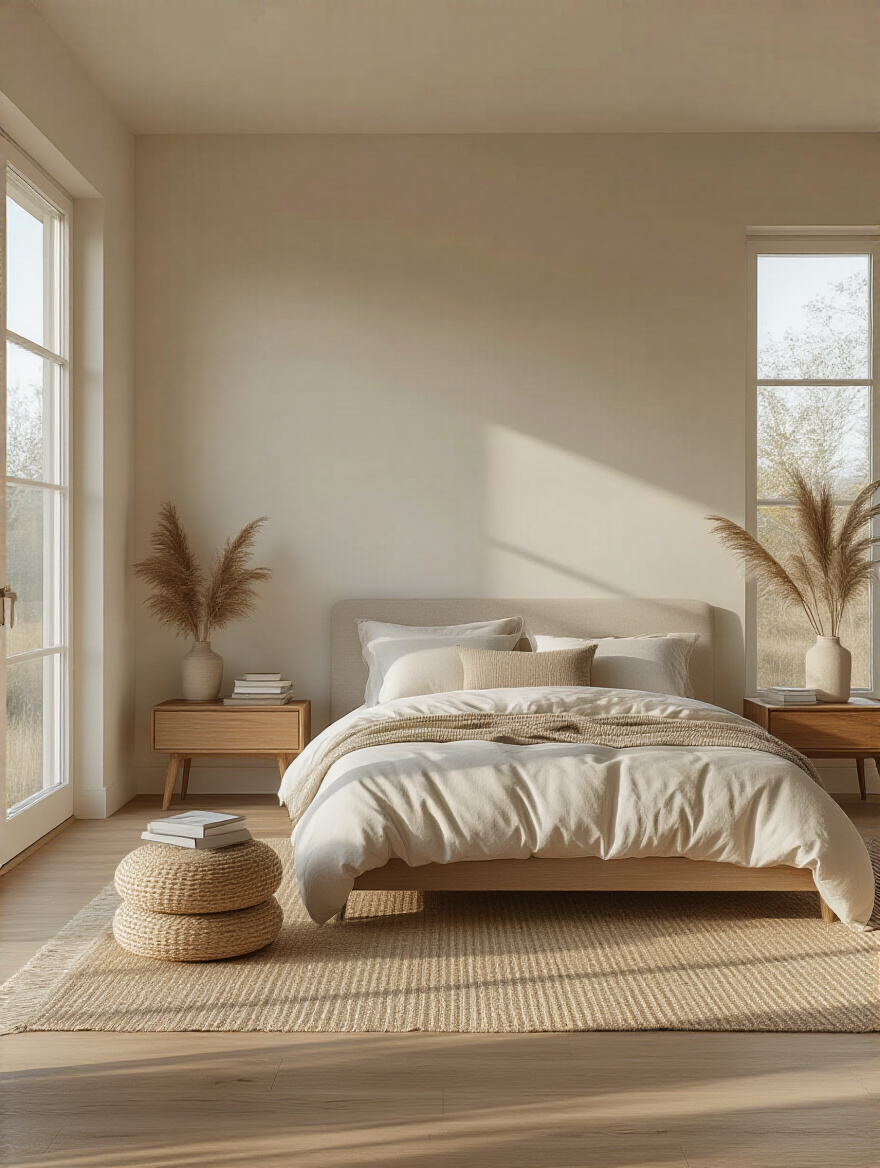
I once had a client who loved both industrial metal and cozy Scandinavian styles. They kept buying random pieces, and their room was a hot mess of conflicting vibes. We stopped, sat down, and defined the mission: “Industrial Chic meets Warm Comfort.” That one phrase became our North Star. Suddenly, we knew we needed a reclaimed wood bed frame (warm) with a sleek black metal reading light (industrial). It simplified every single decision from then on and saved them from another expensive mistake.
Your aesthetic statement is your roadmap. No more guessing, no more buying things just because they’re on sale.
2. Cultivate Serenity with a Minimalist Color Palette.
Think of your room’s color palette as its user interface. Is it busy and chaotic like a website from 1999, with a million things screaming for your attention? Or is it clean, intuitive, and calming like the best modern apps? A minimalist palette—and I don’t mean just “all white”—is about limiting your choices to a few tones that work in perfect harmony. It immediately lowers your brain’s cognitive load.
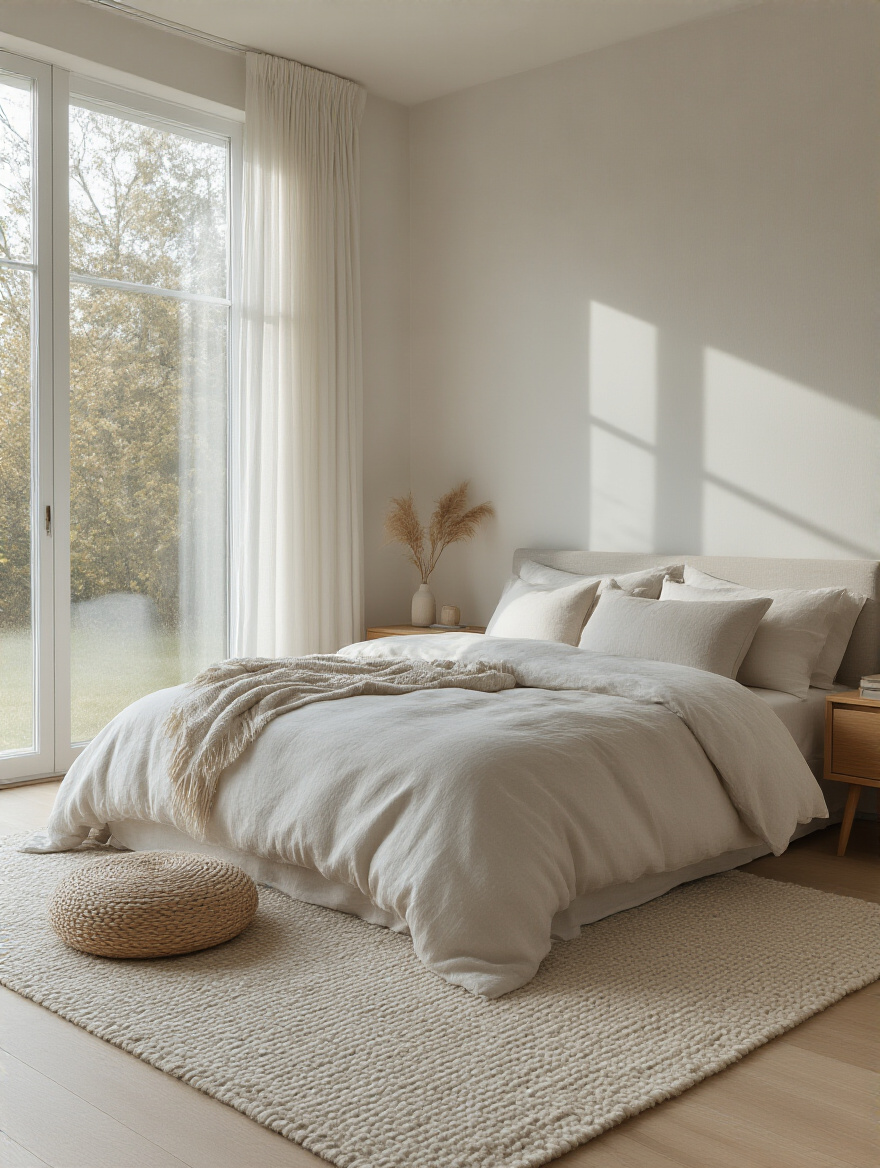
Start with a dominant, soft neutral for your walls—think light grays, warm off-whites, or even a muted sage green. That’s about 70% of your UI. Then pick one or two accent colors for things like pillows, a throw blanket, or a piece of art. That’s it. It’s not about being boring; it’s about being intentional. A limited palette makes a room feel bigger, cleaner, and lets the textures and shapes of your furniture do the talking.
The shortcut? Use a tool like Coolors.co to generate palettes, or just walk into a high-end paint store and look at their pre-selected “designer collections.” They’ve done the hard work for you.
3. Prioritize Decluttering for a Visually Expansive Bedroom.
Look, you can have the most expensive furniture in the world, but if it’s buried under a mountain of clothes, books, and random junk, your room will feel cheap and stressful. Decluttering isn’t just about cleaning up. It’s about optimizing your environment so your brain can actually relax. Every stray object on your nightstand is one more thing your brain has to process, consciously or not. It’s visual noise that kills the chill vibe.

The best trick I ever learned is the “Four-Box Method.” Get four bins and label them: Keep, Donate/Sell, Trash, and Relocate. Go through every single item in one area—like your closet or your dresser—and force yourself to put it in a box. No “maybes.” It’s a simple algorithm that works every time. Once you’ve cleared the decks, you’ll be shocked at how much bigger and more peaceful the room feels.
You have to be ruthless. If it doesn’t serve a purpose or bring you legitimate joy, it doesn’t belong in your sanctuary. Period.
4. Incorporate Clean Lines for a Streamlined, Sleek Look.
Now that the room can breathe, let’s talk about form. “Clean lines” just means furniture and architecture without a bunch of fussy, ornate details. Think about the difference between a sleek, modern smartphone and one of those old-school remote controls with 80 identical little rubber buttons. Which one feels more orderly and sophisticated? It’s the same with furniture.
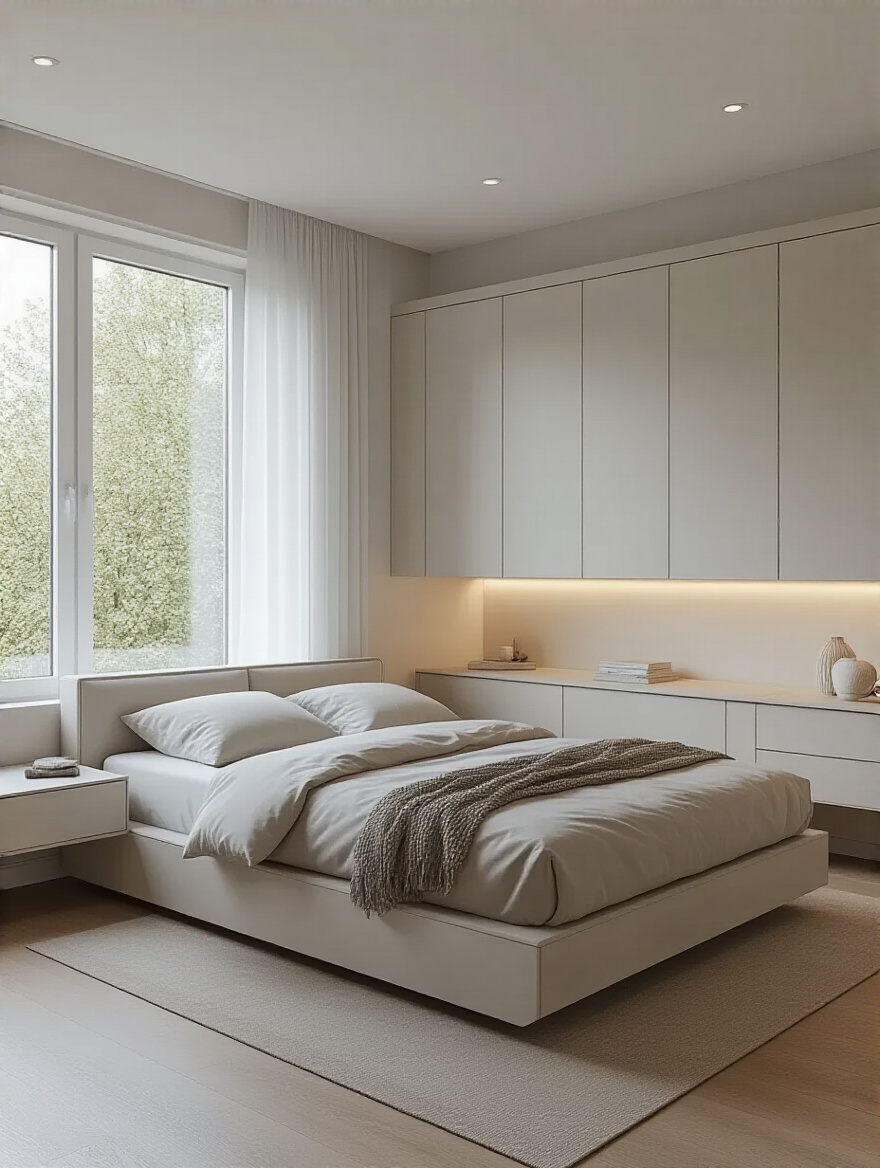
Opt for stuff with simple, geometric shapes. A platform bed with a straight-edged frame. A dresser with flat-front drawers and no elaborate handles. Floating shelves instead of a clunky bookcase. These simple, uninterrupted lines draw your eye smoothly through the space, making it feel cohesive and calm. It’s an understated confidence. The room doesn’t need to shout to be noticed.
I learned this the hard way years ago. I bought a bed with this big, swirly, ornate iron headboard. I thought it was “classic.” In reality, it was just visual chaos. It chopped up the wall behind it and made the whole room feel busy. I sold it and got a simple, low-profile wooden platform bed, and the entire vibe of the room shifted from “fussy” to “focused.”
Strategic Furniture Selection & Layout
Alright, the foundation is set. Now we bring in the hardware. This is about choosing pieces that are not only cool to look at but also make the room function flawlessly. Every piece of furniture should be a brilliant solution, not another problem.
5. Select a Low-Profile Platform Bed for Contemporary Appeal.
Your bed is the anchor of the whole room, and a low-profile platform bed is the ultimate modern choice. By sitting closer to the ground, it instantly makes the room feel taller and more open. It lowers the entire eyeline of the space, which has this incredible psychological effect of making it feel more like a relaxed lounge and less like a formal, stuffy bedroom. It’s a total game-changer for the vibe.

Plus, let’s get real about the entertainment angle. A lower bed means you have a bigger, cleaner wall opposite it, which is prime real estate for a projector screen. Suddenly, your bedroom isn’t just for sleeping; it’s a private cinema. A low-slung bed, some great pillows, and a 100-inch screen appearing on your wall? That’s how you turn a bedroom into a five-star experience.
Forget bulky box springs and towering bed frames. Sleek, low, and solid is the way to go. It’s the perfect foundation for both sleep and play.
6. Choose Integrated or Floating Nightstands for Modern Flow.
If there’s one thing that drives me absolutely crazy, it’s a tangled mess of wires. Wires are the enemy of chill. And the worst offender is usually the nightstand, with its lamp cord, phone charger, and who-knows-what-else creating a digital rat’s nest. Floating or integrated nightstands are the ultimate fix. They mount directly to the wall or the headboard, keeping the floor completely clear.
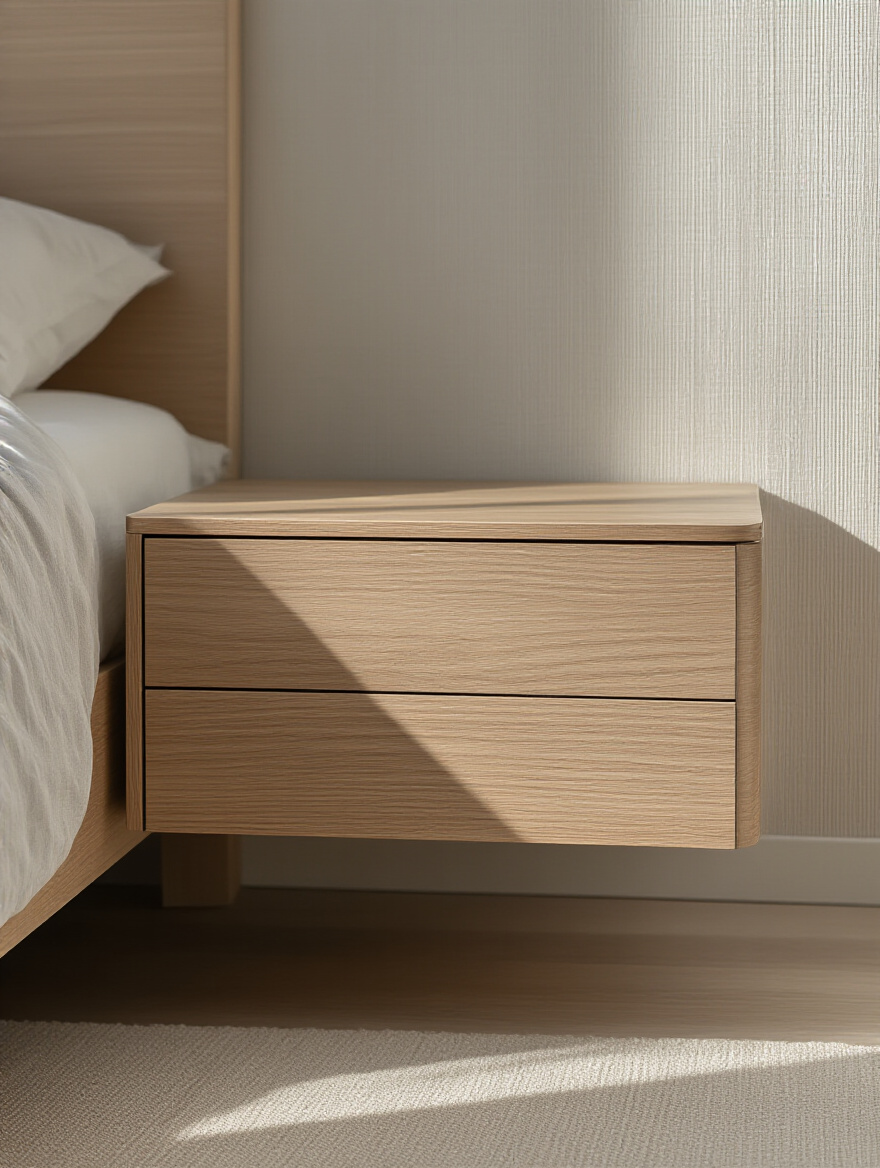
This does two amazing things. First, it makes the room feel way bigger and easier to clean. Second, it’s the perfect opportunity to manage your tech. You can run wires behind the wall for a clean, floating look for your lamp. Even better, you can get models with built-in USB ports or even integrate a wireless Qi charging pad right into the surface. Just set your phone down, and it charges. No cables, no mess.
It’s a sleek, high-tech solution that looks incredibly clean and makes your life just a little bit more seamless. That’s what good design is all about.
7. Maximize Floor Space with Smart vertical storage solutions.
In most bedrooms, the biggest waste of space is the air. We cram stuff into bulky dressers and closets, but we leave our walls totally empty. Smart vertical storage is about treating your walls like prime real estate. Think floor-to-ceiling built-in wardrobes, tall and slender dressers, or sleek floating shelves that climb the walls. It’s like cloud storage for your physical possessions.

Getting everything off the floor and onto the walls has a massive impact. It makes the room feel incredibly open and uncluttered. For one client in a tiny city apartment, we designed a single wall unit that had everything: closet space, drawers, display shelves, and even a hidden fold-down desk. It sounds like a lot, but because it was all one seamless, floor-to-ceiling piece, it made the room feel twice as big by eliminating the need for three other bulky pieces of furniture.
My pro tip? Design your vertical storage to hide the ugly stuff. A cabinet can conceal your Wi-Fi router, a power strip for all your chargers, and other tech clutter, keeping your sanctuary looking serene.
8. Optimize Layout for Seamless Movement and Openness.
Ever been in a room where you constantly have to shimmy past a piece of furniture? It’s awful. That’s a layout with bad ‘user flow.’ Your bedroom should feel as frictionless as a great app. The path from the door to the bed, from the bed to the closet—these are user journeys, and they need to be clear and effortless. A good rule of thumb is to have at least 30-36 inches for your main walkways.
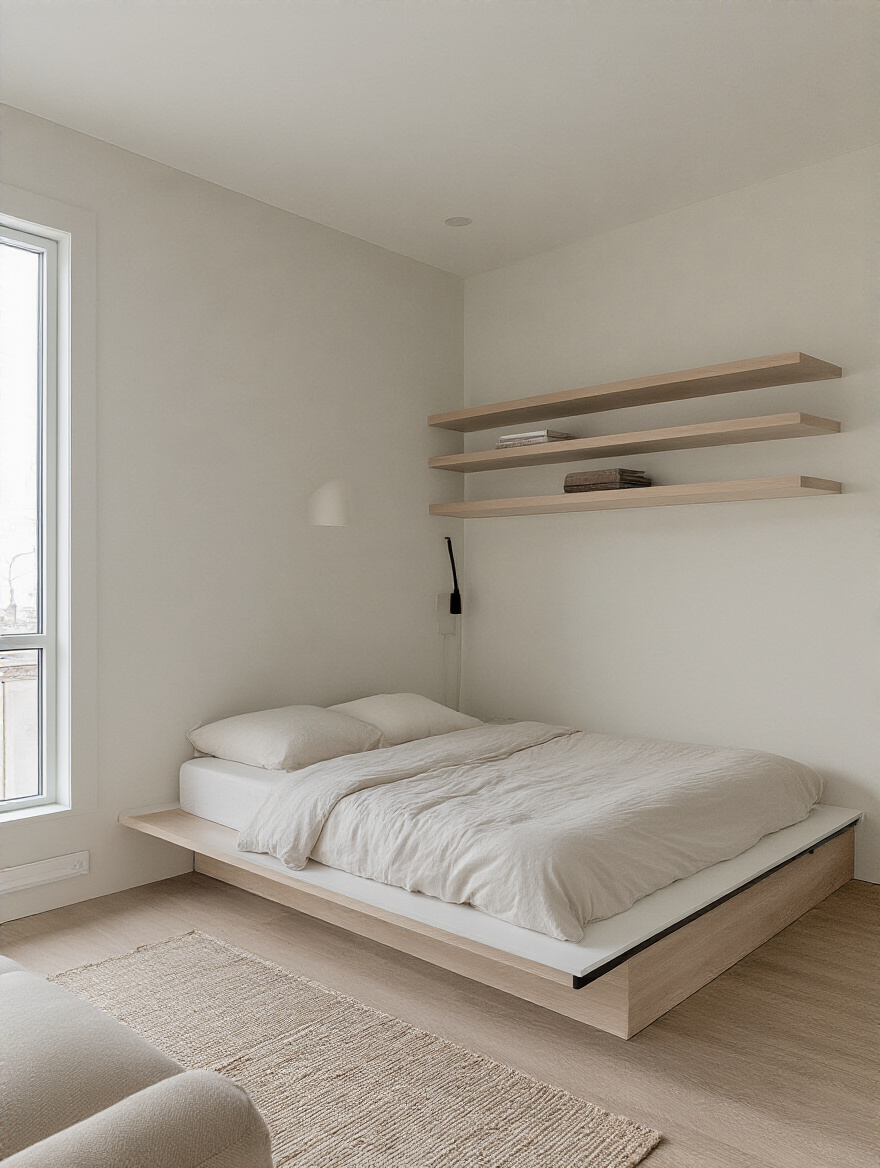
Here’s the shortcut I use with every client: painter’s tape. Before you move a single heavy thing, map out the footprints of your furniture on the floor with tape. Then, walk the paths. Does it feel cramped? Can you open the drawers all the way? This five-minute exercise can save you hours of back-breaking work and prevent you from creating a layout that just doesn’t work.
Think like a game designer mapping out a level. You want clear paths, no dead ends, and an intuitive flow that makes navigating the space feel completely natural.
Illuminating with Purpose & Textural Depth
Okay, the room is laid out and the furniture is dialed in. Now it’s time for the magic. Lighting and texture are what take a room from “well-designed” to “wow, I never want to leave.” This is how you create a mood and make a minimalist space feel warm and inviting.
9. Layer Ambient and Task Lighting for Mood Control.
Relying on one single, boring overhead light is like trying to watch a 4K movie on an old flip-phone screen. It technically works, but the experience is terrible. Great lighting is all about layers. You need three types: Ambient (the general, overall light from recessed cans or a flush mount), Task (focused light for activities, like a reading lamp), and Accent (light that highlights something cool, like art).
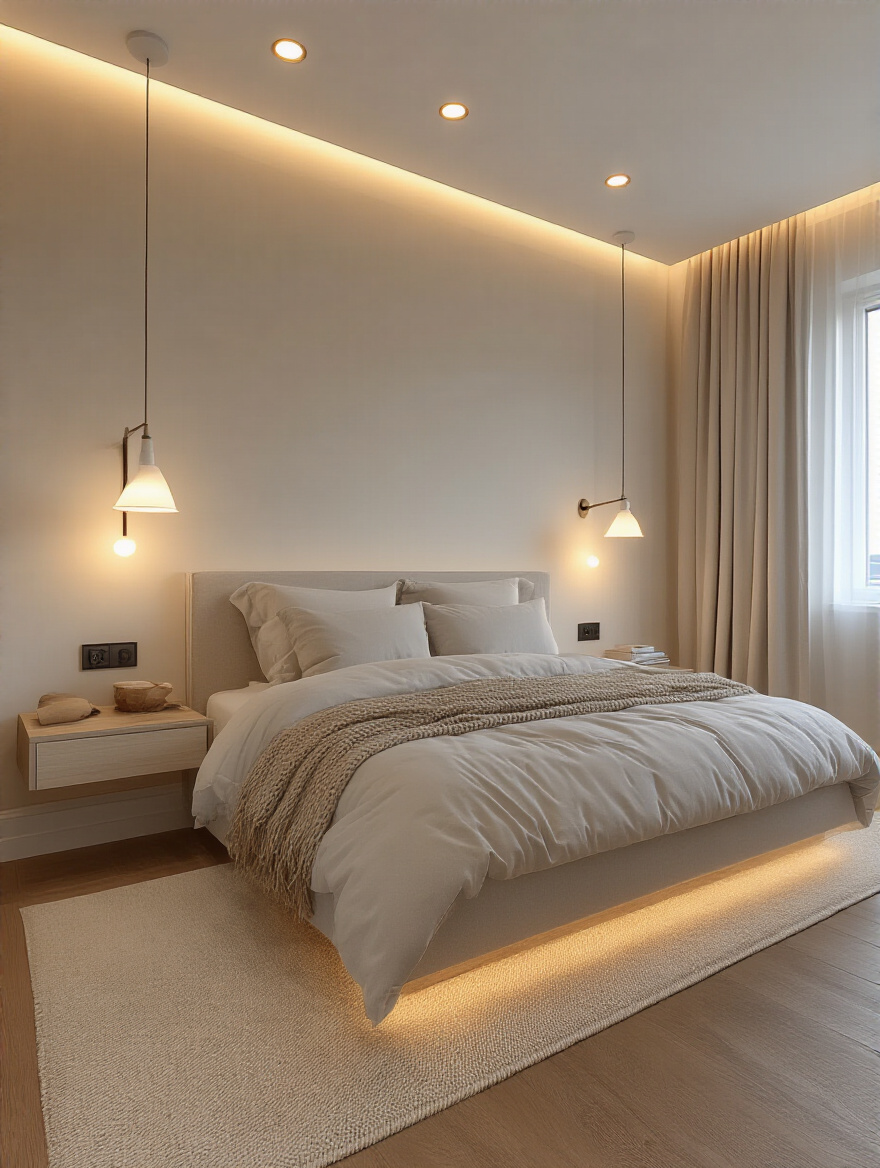
The real pro move is to put every single one of those layers on a dimmer. Dimmers are non-negotiable. They are the single most cost-effective way to completely change the feeling of a room. Even better, use a smart lighting system like Philips Hue. You can create “scenes” for any mood. “Movie Night” could dim the ambient lights to 10%, turn on a soft accent light behind the TV, and turn everything a warm color. “Morning” could slowly brighten the lights to mimic the sunrise.
“Your lighting should adapt to your life, not the other way around. With smart controls, you can craft the perfect vibe for any moment with the touch of a button or a simple voice command.”
This isn’t a gimmick; it’s about giving you total control over the atmosphere of your sanctuary. It’s luxury you can use every single day.
10. Install Sculptural Light Fixtures as Art Pieces.
While your layered lighting does the functional heavy lifting, a sculptural fixture is your showpiece. This is the “jewelry” of the room. It’s a light that you choose more for its beautiful shape than for the amount of light it puts out. Hanging a stunning pendant over your bed or a pair of unique sconces flanking it instantly elevates the entire space.
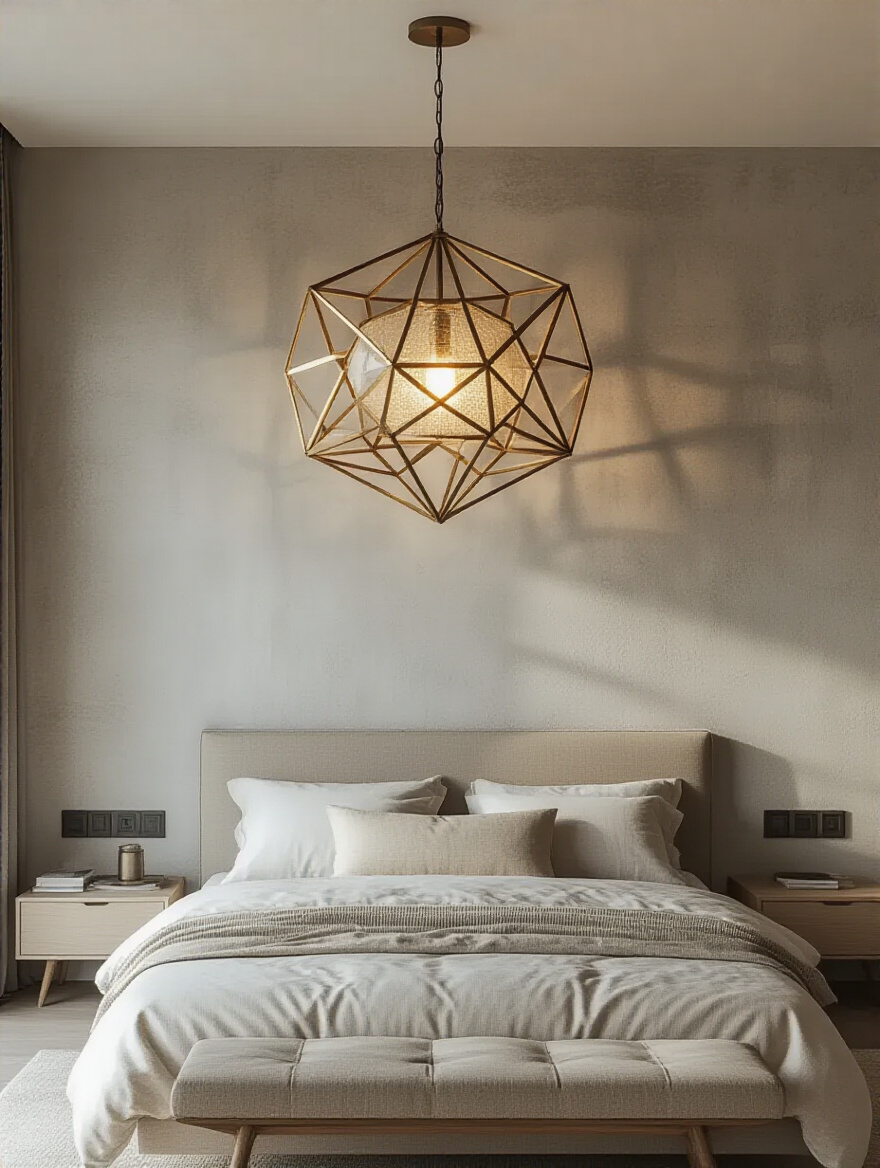
In a modern, minimalist room, you don’t have a lot of “stuff.” So the few things you do have need to be amazing. A sculptural light fixture acts as a focal point and a conversation starter. It adds complexity and personality without adding clutter. It says, “Yeah, every detail in here was chosen on purpose.”
I once saw a bedroom where the only piece of “art” was an incredible, multi-armed mobile-style chandelier. It hung over the bed, casting these gentle, shifting shadows on the ceiling. It was dynamic, beautiful, and utterly captivating. That’s the power of treating light as art.
11. Introduce Natural Wood and Linen Textures for Warmth.
So you’ve got your clean lines and minimalist palette. How do you keep it from feeling cold? Texture. Specifically, natural wood and linen. These are the elements that bring warmth and soul into a modern space. Think of it in terms of tech—it’s all about the haptics. A phone can have the best screen in the world, but if it feels cheap and plasticky in your hand, the experience is ruined.
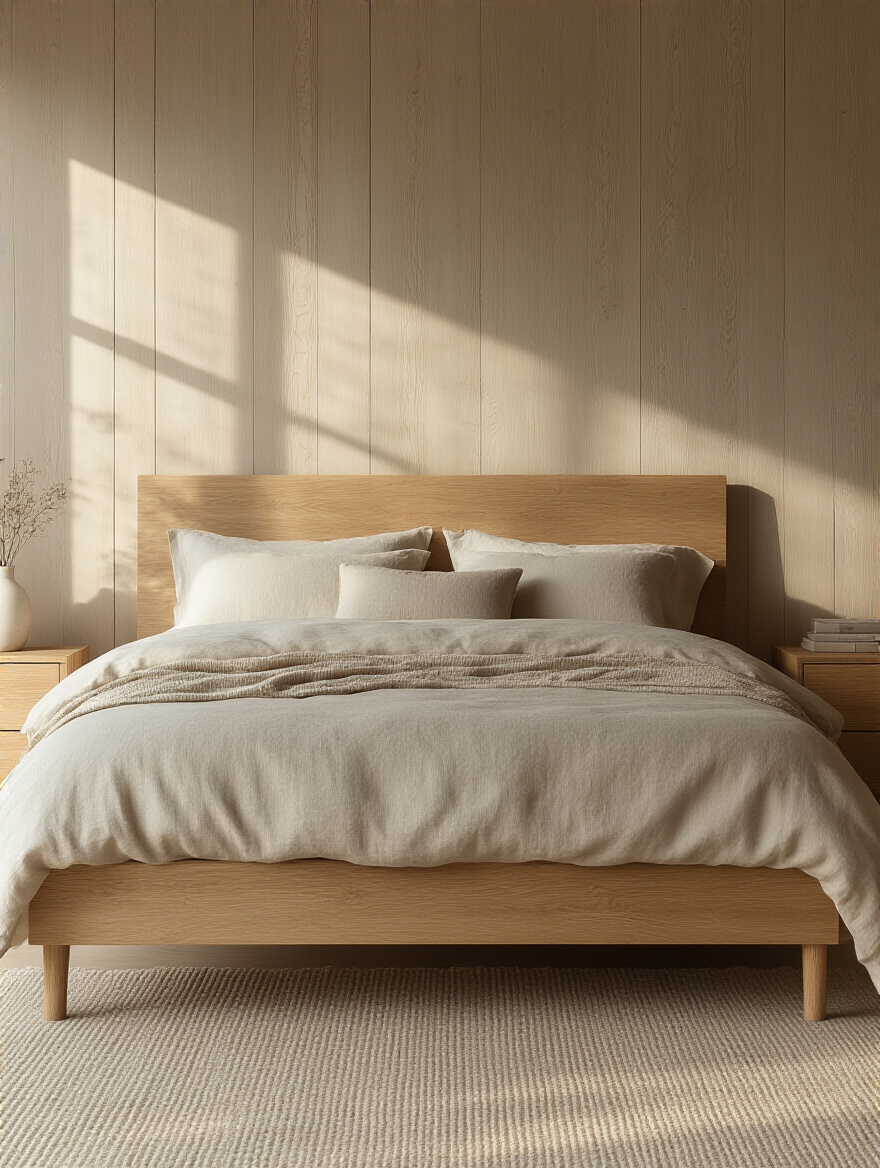
A bed frame made of solid oak or walnut, a soft wool rug underfoot, and bedding made from real, breathable linen—these things provide a tactile richness that balances out the sleekness of modern design. Linen, especially, is a superstar. It’s relaxed, breathable, and has this effortlessly rumpled look that feels incredibly inviting.
Don’t be afraid to mix wood tones, either. A light oak floor with a darker walnut dresser adds depth and character. The key is to let the natural, organic beauty of the materials shine through.
12. Add Abstract Wall Art for a Striking Focal Point.
Okay, your walls are clean, maybe a nice neutral color. You need a focal point, something to anchor the space. A large piece of abstract art is the perfect solution for a modern room. Because it’s not a picture of something specific (like a landscape or a portrait), it doesn’t distract the mind. Instead, it adds a powerful punch of color, shape, and emotion.
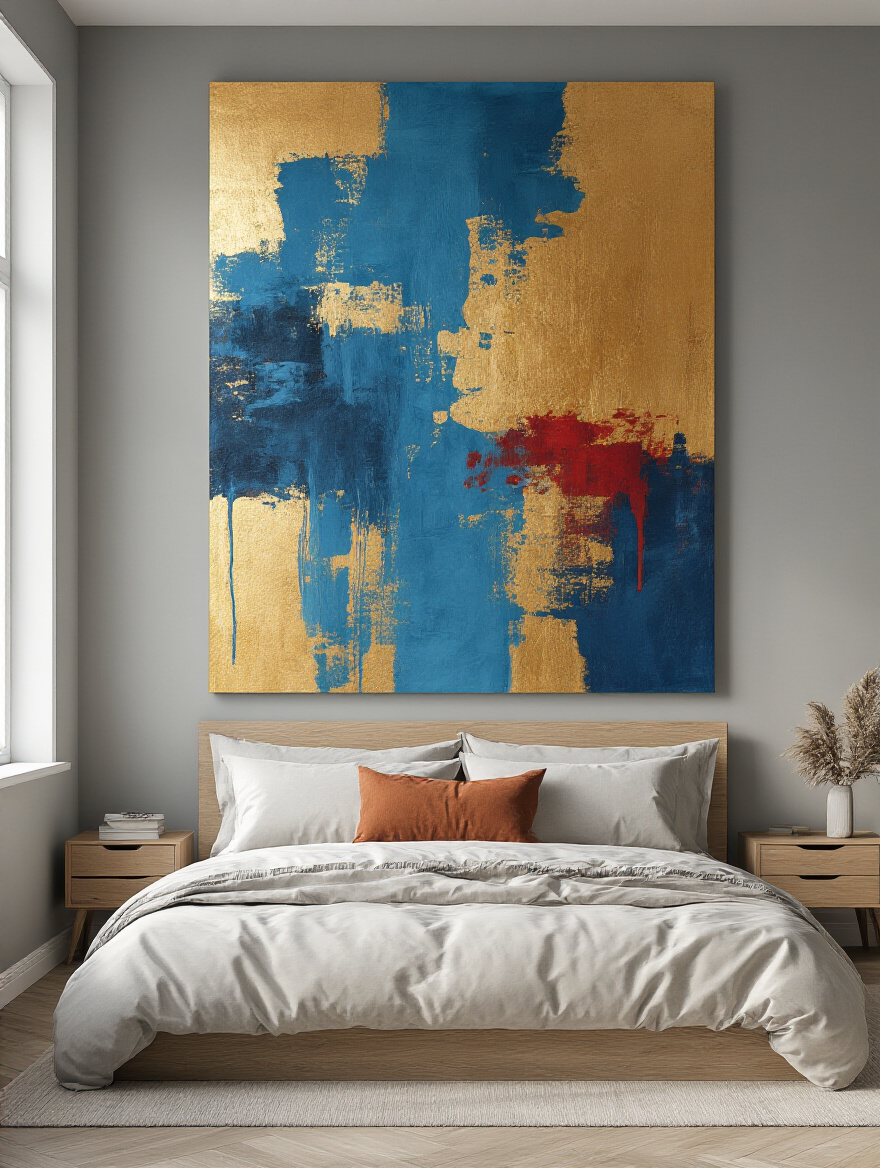
Think of it as the custom “wallpaper” or “home screen” for your room. It sets the entire vibe. A piece with soft, flowing blues and grays will feel calming. One with a bold slash of red will feel energetic. It’s the perfect way to tie all the colors in your room together—you can even sync your smart lights to pull colors directly from the artwork for a fully immersive, coordinated look.
My rule of thumb: go big. A small, lonely picture on a big wall looks sad. A large canvas that takes up about two-thirds of the width of the furniture below it (like your bed’s headboard) looks confident and intentional.
Curated Details & Practical Organization
We’ve reached the final boss: the details. This is the stuff that separates a good room from a truly great one. It’s about how you live in the space day-to-day. Seamless storage, smart tech, and daily routines are the secret ingredients to maintaining that feeling of zen.
13. Utilize Built-in or Hidden Storage for Pristine Surfaces.
Clutter is the nemesis of a modern aesthetic, and the best way to defeat it is with storage so sneaky it’s practically invisible. Built-in and hidden storage that blends seamlessly into the walls is the gold standard. This could be a wardrobe painted the exact same color as the walls, drawers with push-to-open mechanisms so you don’t need handles, or a bed platform with deep, hidden drawers underneath.
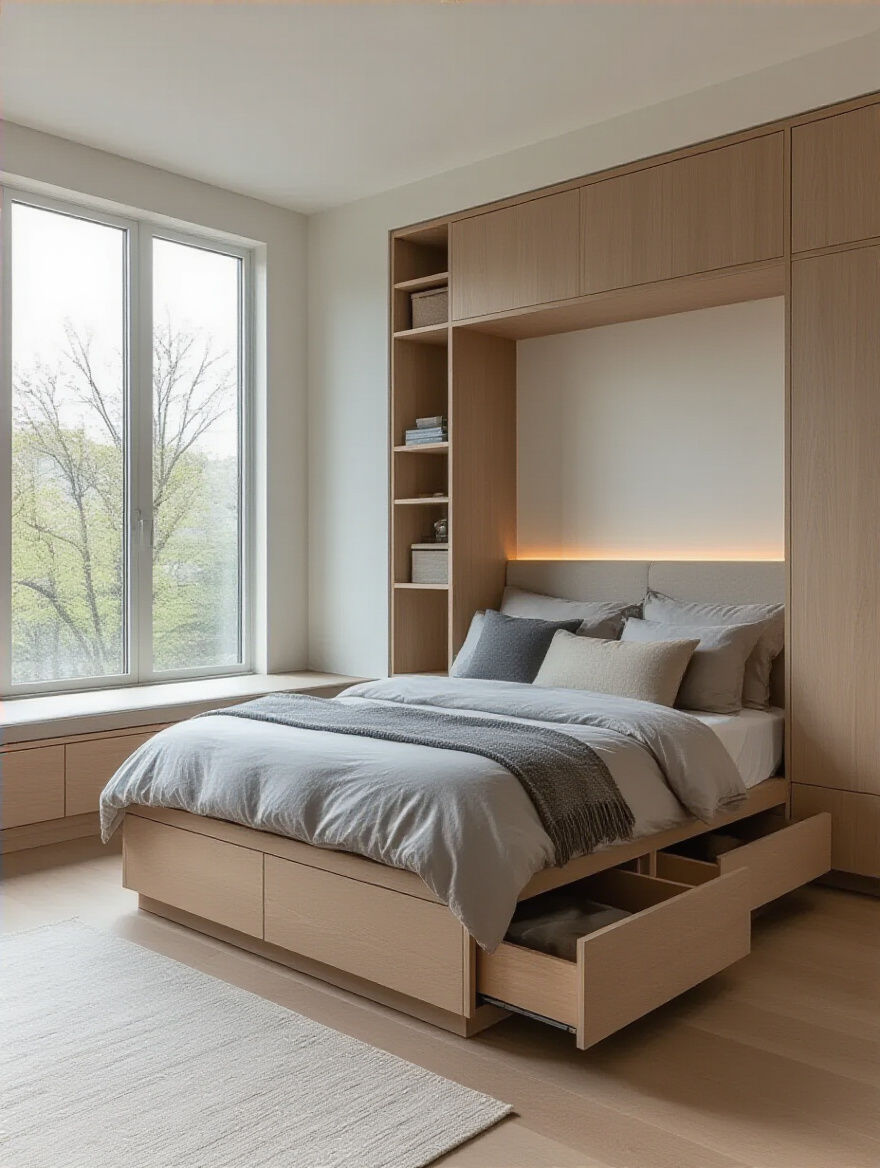
The goal is to have pristine, clear surfaces. This isn’t just for looks; it has a profound effect on your mental state. A clear surface signals to your brain that there’s nothing that needs to be “done,” allowing you to fully relax. It makes a room feel bigger, cleaner, and infinitely more peaceful.
This is also where you hide all the unsexy but necessary tech. Routers, power bricks, cable boxes—they can all live inside a beautiful built-in, out of sight but still perfectly functional.
14. Curate Meaningful, Minimal Accessories Thoughtfully.
Now that your surfaces are clear, you can be extremely intentional about what you put back. Think of your accessories like the icons on your phone’s dock. You don’t have every app there, just the few essentials you use constantly or love the most. Your bedroom surfaces should be the same.
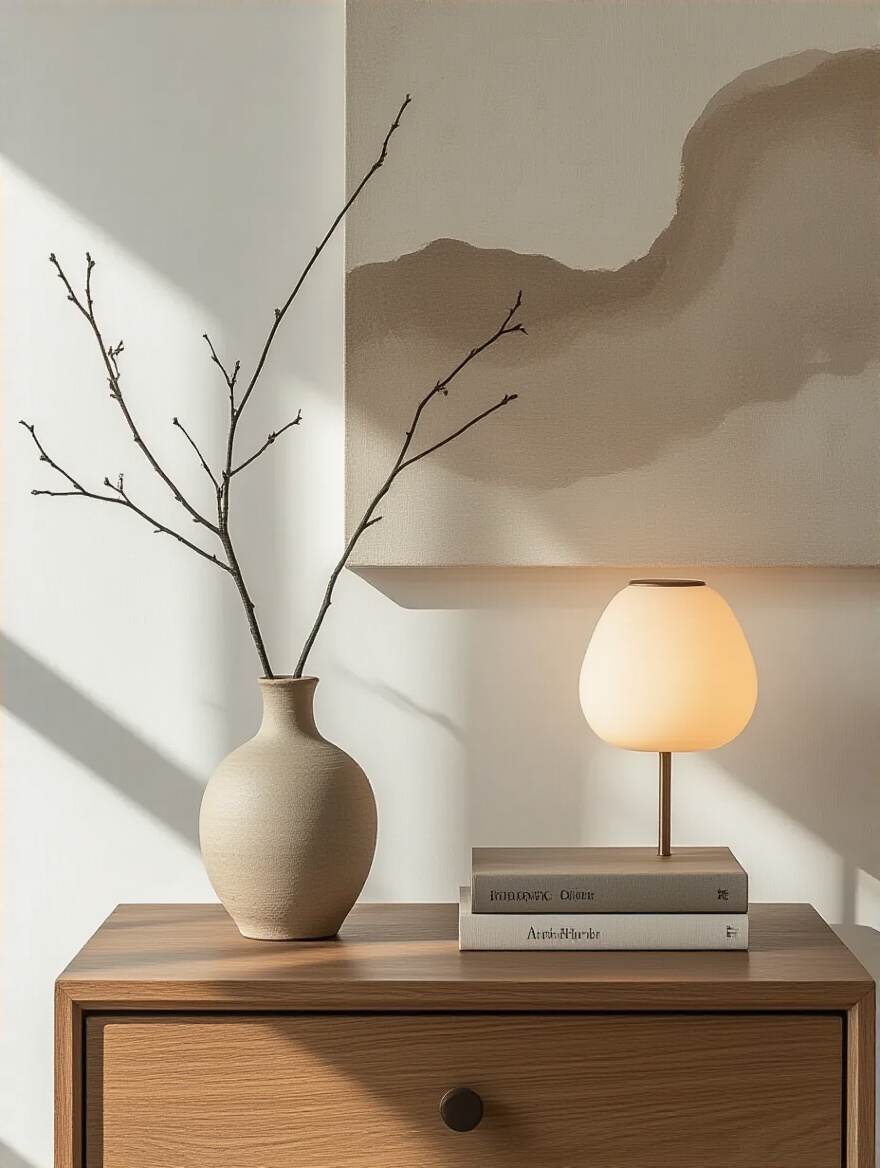
Choose a few—and I mean a few—things that are either super functional (like a beautiful alarm clock or a charging valet) or deeply meaningful (a single framed photo, a special souvenir, a favorite art book). Group them in little clusters of odd numbers (like one or three items) and give them plenty of “negative space” to breathe.
I once helped a client who had dozens of little knick-knacks scattered everywhere. We packed them all away and put back just three things on their dresser: a small, beautiful plant; a photo of their family in a simple frame; and a gorgeous ceramic bowl to drop their keys in. The transformation was insane. The room went from cluttered and chaotic to calm and curated.
15. Invest in High-Quality, Crisp, Solid Color Bedding.
Your bed is the biggest piece of furniture in the room. What’s on it is the most dominant textile. Investing in amazing bedding is like upgrading the processor in your computer—it impacts everything. Forget busy patterns and cheap polyester. You want high-quality, solid-colored bedding made from natural fibers.
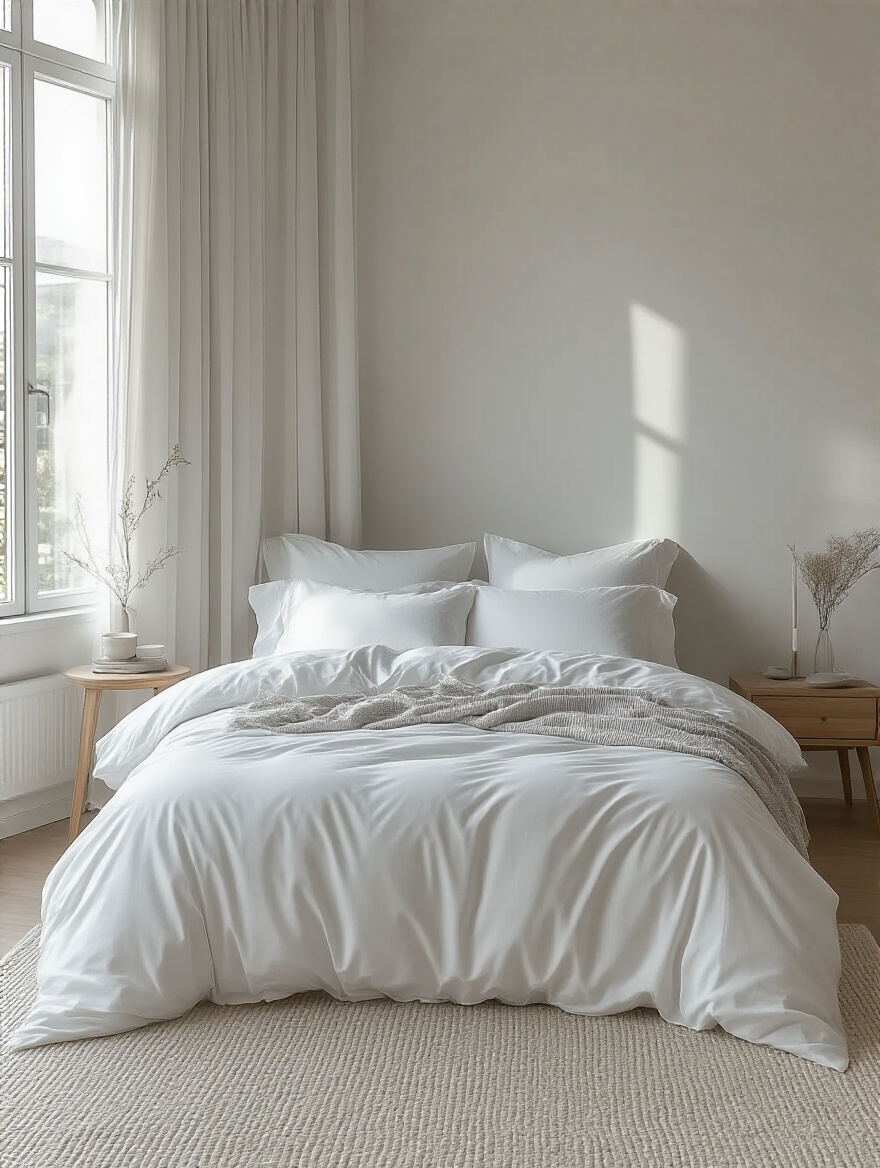
Here’s the shortcut guide: If you want that crisp, cool, five-star-hotel feel, get percale weave cotton. If you want a silkier, smoother, more drapey feel, get sateen weave cotton. If you want a relaxed, breathable, perfectly imperfect look, get linen. And stick to solid colors—crisp white, soft gray, deep charcoal, or muted blues and greens. It creates a calm, clean canvas.
This is one of the most impactful upgrades you can make. Good bedding doesn’t just look better; it feels better and can genuinely help you sleep better. It’s an investment in your well-being.
16. Integrate Greenery with Simple, Elegant Indoor Plants.
A modern room can sometimes feel a little too perfect, a little too man-made. The easiest way to inject some life and organic energy is with plants. You don’t need to turn your bedroom into a jungle, but one or two well-chosen plants can make a world of difference. They literally clean the air you breathe and have been proven to reduce stress.
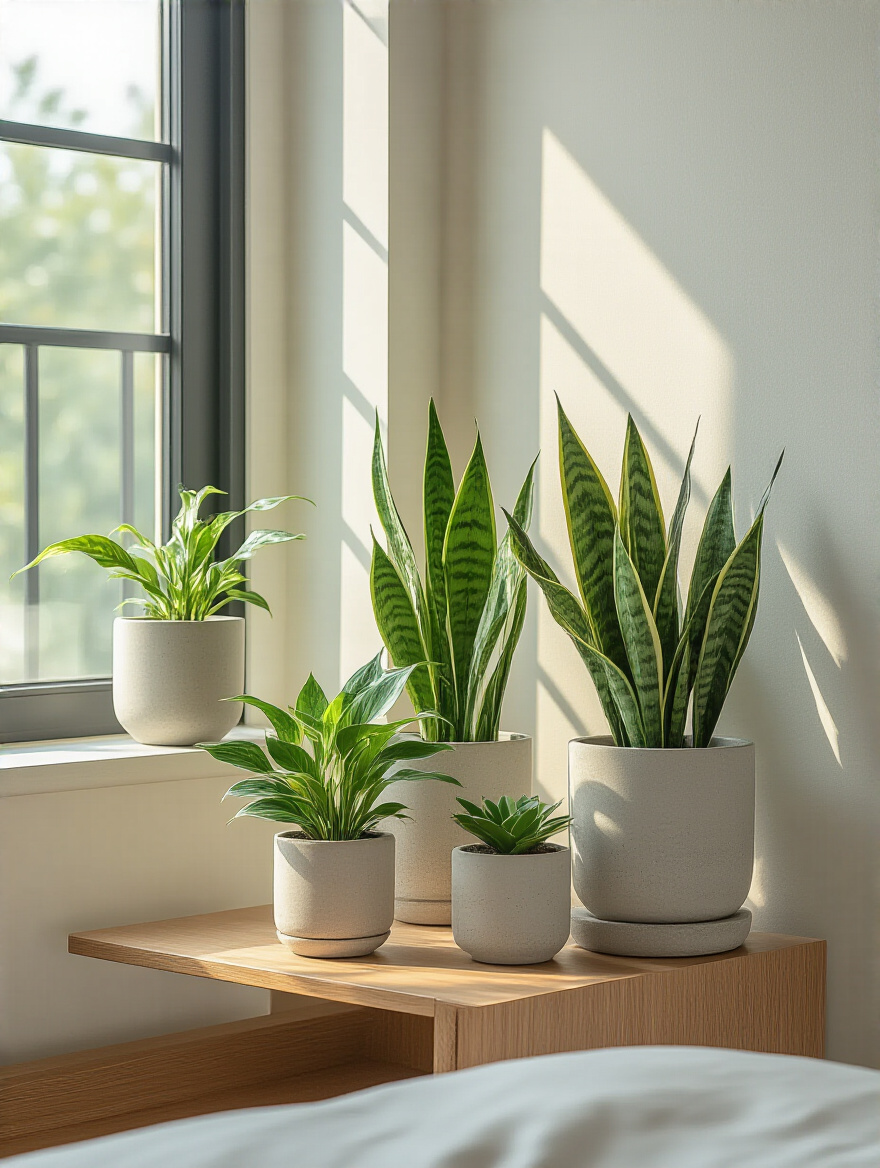
Pick plants that are hard to kill, like a Snake Plant or a ZZ Plant. And pay attention to the pot! A cheap, ugly plastic pot will kill the vibe. Invest in a simple, elegant planter made of ceramic, concrete, or matte metal that complements the rest of your room’s decor.
A tall plant in a corner adds vertical interest. A small succulent on a nightstand adds a little touch of life. It’s like adding a living, breathing, analog sculpture to your high-tech sanctuary.
17. Incorporate Smart Home Technology for Effortless Comfort.
This is where the magic really happens for me. Your bedroom shouldn’t just be a passive space; it should be an active environment that works for you. Integrating smart home tech is about creating effortless comfort. Imagine saying “Good night,” and your lights slowly dim, your smart blinds close, your thermostat adjusts to the perfect sleep temperature, and a white noise machine quietly starts up. That’s not science fiction; that’s a Tuesday night.
Start with a smart hub like an Amazon Echo or Google Nest. Then, add smart bulbs, a smart thermostat, and maybe even motorized blinds. You can create routines for every part of your day. A “Wake Up” routine can slowly brighten your lights and raise the shades to help you wake up naturally, without a jarring alarm.
A truly smart home isn’t about flashy gadgets; it’s about automating the small, annoying tasks so you have more time and mental energy for what truly matters: relaxing, recharging, and connecting.
This level of personalization and control is the ultimate modern luxury. It turns your room into a responsive sanctuary that anticipates your needs.
18. Optimize Window Treatments for Light, Privacy, and Style.
Your windows are a huge source of light and a potential weak point for privacy. Getting the window treatments right is critical. For a bedroom, your goal is ultimate control. This is why I almost always recommend a layered approach: a blackout roller shade for complete darkness, paired with soft, sheer curtains for diffused light and privacy during the day.

Light is the number one enemy of good sleep and a good movie-watching experience. A high-quality blackout shade that’s properly fitted to your window frame will plunge the room into perfect darkness, which is essential for melatonin production. The sheer curtains in front soften the look and add a bit of texture, so it doesn’t just look like a home theater CAVE.
And yes, you can get motorized, smart versions of these. Being able to open or close all your shades with one button or a voice command is a small luxury that you will appreciate every single day.
19. Enhance Sleep Quality with Thoughtful Acoustic Elements.
You can have the most beautiful, comfortable room in the world, but if you can hear your neighbor’s TV or traffic from the street, you won’t get good rest. You have to control the audio environment just as much as the visual one. This means adding soft things that absorb sound.
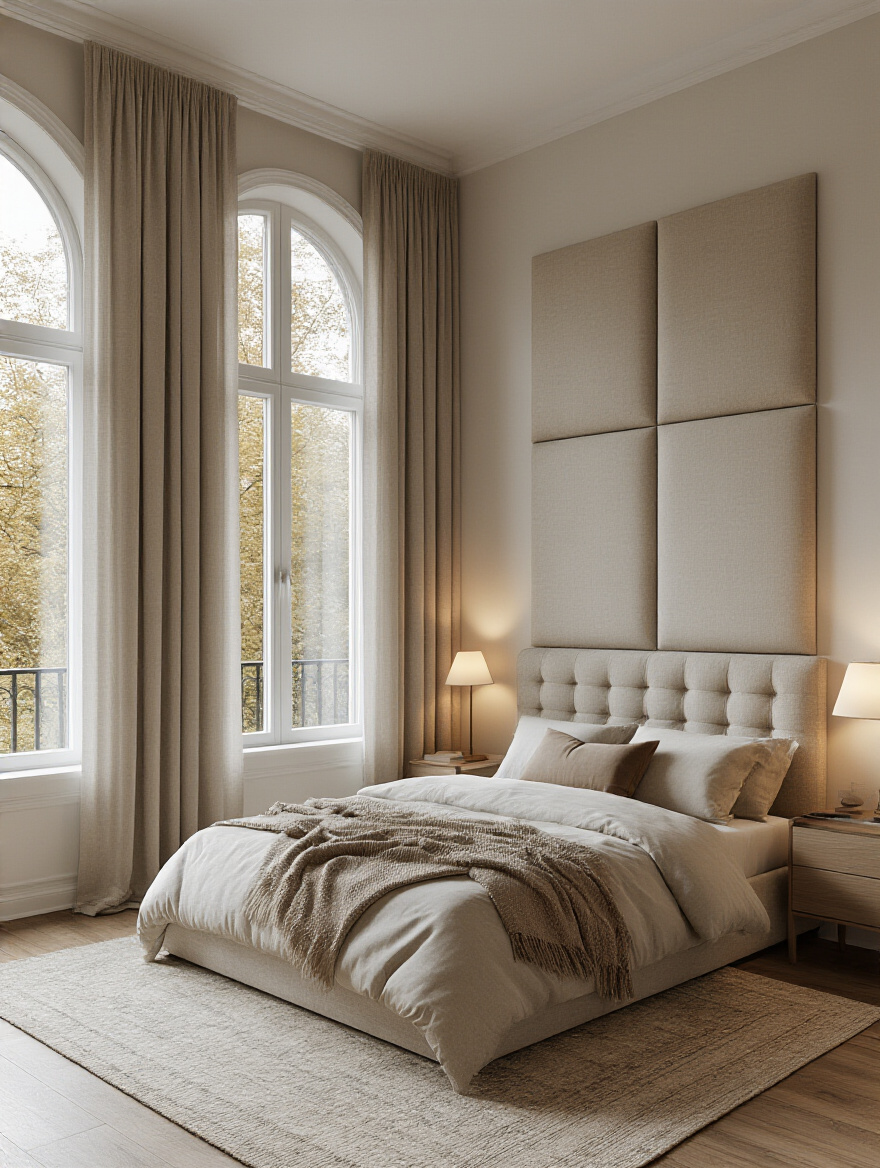
A big, thick, plush area rug is your best friend. It does more to dampen sound than almost anything else. An upholstered headboard, heavy blackout drapes, and even acoustic art panels (which look like cool abstract art but are made of sound-absorbing material) can all contribute to a quieter, more peaceful space.
I had a client whose bedroom faced a busy street. The noise was wrecking their sleep. We installed a solid-core door (hollow ones are terrible for sound), thick acoustic curtains, and a giant wool rug. The difference was night and day. It created a quiet cocoon where the outside world just melted away.
20. Maintain a Clean-Surface Routine for Daily Zen.
This is the last and maybe most important tip. All this amazing design work means nothing if you don’t maintain it. The secret is to create a simple, repeatable routine. I call it the “5-Minute Tidy” or the “daily system cache clear.” Before you go to bed, take just five minutes to put everything back where it belongs. Fold the clothes. Put the book back on the shelf. Wipe down the nightstand.

This isn’t about deep cleaning. It’s about a quick reset. It stops the little bits of clutter from piling up and turning into a big, overwhelming mess. It’s a habit that pays huge dividends in mental clarity. Waking up to a clean, orderly space sets a positive, calm tone for your entire day.
Combine this with the “One-Touch Rule”—when you pick something up, put it away immediately, don’t just set it down somewhere else. These small daily disciplines are what turn a beautifully designed room into a sustainable sanctuary for the long haul.
Conclusion: Your Journey to a Modern Bedroom Sanctuary
So there you have it. A modern bedroom isn’t about being cold or empty. It’s about being intentional. It’s about building a personalized, high-performance recharge station that’s smart, outrageously comfortable, and uniquely you. From laying a foundation of clean lines and a calm palette to layering in smart tech, killer acoustics, and luxurious textures, every one of these ideas is a tool to help you craft a space that actively improves your well-being.
Forget the catalogs and the showrooms. This is your space. It’s where the most important person in your life—you—gets ready to take on the world. Start small. Pick one or two of these ideas and run with them. Invest in great bedding. Declutter your nightstand. Install a dimmer switch. You’ll be amazed at how quickly you can transform your room from just a place where you sleep into the tranquil, intelligent, and inspiring escape you absolutely deserve. Go build your sanctuary.
